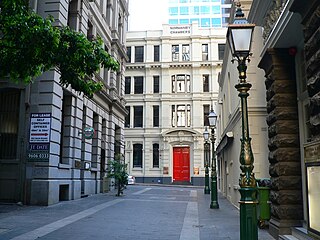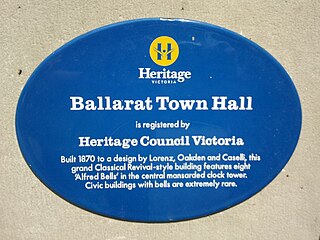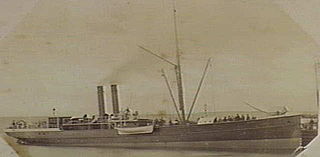
The Victorian Heritage Register (VHR) lists places deemed to be of cultural heritage significance to the State of Victoria, Australia. It has statutory weight under the Heritage Act 2017. The Minister for Planning is the responsible Minister. Heritage Victoria was established as the State Government listing and permit authority in 1995, replacing the original authority, the Historic Buildings Preservation Council, established in 1974. Listing on the Victorian Heritage Register is separate from listing by a local Council or Shire, known as a Heritage Overlay. Heritage Victoria is currently part of the Department of Environment, Land, Water and Planning of the Government of Victoria, Australia. Heritage Victoria reports to the Heritage Council who approve recommendations to the Register and hear appeals when a registration is disputed. The council also hears appeals by an owner to a permit issued by Heritage Victoria. As of 2021, there are over 2,400 places and objects listed on the VHR.
Point Hicks, is a coastal headland in the East Gippsland region of Victoria, Australia, located within the Croajingolong National Park. The point is marked by the Point Hicks Lighthouse that faces the Tasman Sea.

Treasure hunting is the physical search for treasure. For example, treasure hunters try to find sunken shipwrecks and retrieve artifacts with market value. This industry is generally fueled by the market for antiquities. The practice of treasure-hunting can be controversial, as locations such as sunken wrecks or cultural sites may be protected by national or international law concerned with property ownership, marine salvage, sovereign or state vessels, commercial diving regulations, protection of cultural heritage and trade controls.

Bank Place is a street in Melbourne, Australia. It is a laneway running roughly north-south between Collins Street and Little Collins Street in the central business district.

Heritage Victoria is a Victorian State Government agency responsible for administering the Heritage Act 1995 and supporting the work of the Heritage Council of Victoria.

SS Alert was a steamship that sank off Cape Schanck, Victoria, Australia on 28 December 1893. The ship was built for the gentle waters of Scottish lochs and was almost 51 m (167 ft) long and weighed 247 tonnes.
SS Cheviot was an iron screw steamer built by Charles Mitchell and Co., of Low Walker, Newcastle upon Tyne, England in 1870. She was owned by Wm. Howard Smith & Sons, Melbourne, Australia, for the transportation of coal and passengers. In 1887, she was wrecked in rough seas near Point Nepean in Victoria, Australia, with the loss of 35 lives, after the propeller was disabled. The beach nearby was subsequently named Cheviot Beach.

The Sturt Street Gardens is a central reservation running along Sturt Street, one of the main thoroughfares of Ballarat,. The formal gardens span 13 city blocks from Grenville Street in the east to Pleasant Street in the west, are 20 metres (22 yd) wide and cover an area of 2.87 hectares running east–west.

SS City of Launceston was a 368 GRT steamship operated by the Launceston and Melbourne Steam Navigation Company from 1863, which had an early role in colonial steam shipping as the forerunner of the modern Bass Strait ferry service between Tasmania and Victoria. It was sunk in Port Phillip Bay after a collision with another ship on 19 November 1865.
The Grampians is an Australian wine region located in the state of Victoria, west of Melbourne. It is located near the Grampians National Park and the Pyrenees hills. The area is dominated by red wine production, particularly Shiraz and Cabernet Sauvignon.

The Joseph H Scammell was a Canadian sailing ship that was built at Eatonville, Nova Scotia in 1884 and shipwrecked at Point Danger, Torquay, Victoria, Australia in 1891. Her wreck triggered a large scale episode of shipwreck pilfering and smuggling.
Jack Kenneth Loney was an amateur Australian marine historian who published over one hundred books and numerous newspaper and magazine articles. He was a schoolteacher and principal until his retirement. He became interested in maritime history after preparing several general history booklets covering the Otway region of western Victoria, Australia.

The Adolphe was a sailing ship that was wrecked at the mouth of the Hunter River in New South Wales, Australia, in 1904. The ship is now the most prominent of several wrecks on what is now the Stockton breakwall, which protects Newcastle harbour. The rescue of the ship's crew has gone down in local maritime history as one of the most remarkable in local waters.

The Historic Shipwrecks Act 1976 was an Act of the Parliament of Australia which legally protected historic shipwrecks and any relics or artefacts from those wrecks.

Westgarthtown is a heritage registered precinct located within the Melbourne suburbs of Thomastown and Lalor, in Victoria, Australia.
The Point Hicks Marine National Park is a protected marine national park in situated off Point Hicks in the East Gippsland region of Victoria, Australia. The 4,000-hectare (9,900-acre) marine park is situated approximately 450 kilometres (280 mi) east of Melbourne and 25 kilometres (16 mi) south of Cann River, adjacent to the Croajingolong National Park and Point Hicks Lighthouse Reserve.
The Society for Underwater Historical Research (SUHR) was an amateur maritime archaeology organisation operating in South Australia (SA). It was formed in 1974 by recreational scuba divers and other persons to pursue an interest in maritime archaeology and maritime history. The SUHR was renamed as the South Australian Archaeology Society in March 2012 as part of a plan to expand its activities beyond maritime archaeology to include other archaeological disciplines.

SS Iron Crown was a 3,353 GRT Australian iron ore carrier which was sunk during World War II by a Japanese submarine.

Point Hicks Lighthouse is a lighthouse located on the Point Hicks headland, in the East Gippsland region of Victoria, Australia.
SS Petriana was an iron screw steamer built in 1879 that was converted into an oil tanker. On 28 November 1903, while transporting 1,300 tonnes of petroleum from Borneo to Australia, it struck a reef near Point Nepean, Victoria, outside of Port Phillip Bay. The vessel was subsequently abandoned, but not before its cargo was released as part of efforts to save the ship, causing Australia's first major oil spill. Under the White Australia policy, the Chinese and Malay sailors crewing the Petriana were refused entry to Australia and forced to stay on a crowded tugboat for several days. Their treatment led to a political controversy in the lead-up to the 1903 federal election.













